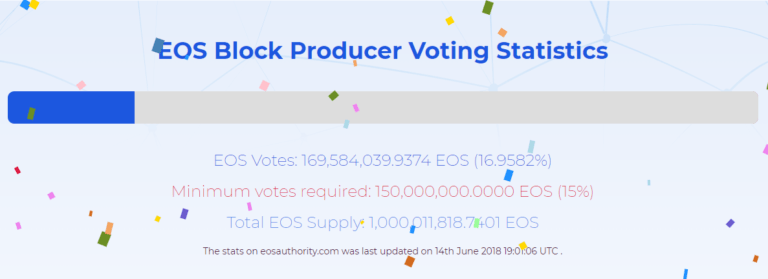
At press time the EOS blockchain has received over 169,000 votes (16.933%) that determines the group of ‘block producers’ that will be tasked with maintaining the EOS network. The successful launch comes as a relief to EOS investors after a nervously slow voting process.
The complex voting system caused worries that EOS holders were apathetic as voters, which could have resulted in votes never exceeding the critical 15% threshold. However, at approximately 18:45 UTC the 15% threshold was met and the 21 temporary and random BPs have been replaced with the 21 officially elected BPs.
According to the EOS ‘Constitution’ the 21 elected block producers do not keep their position forever. In fact, EOS voting is a never-ending process, with votes being recalculated every two minutes to ensure that the set of “active” BPs is constantly changing. So, if BPs want to keep their “job”, they need to make sure they are doing a good job; otherwise some of the “standby” BPs could get more votes and take over from them. You can vote and change your vote as many times you want.
High Hopes for EOS but Questions Remain
Token holders are now able to interact with the EOS blockchain and developers are free to start innovating and testing applications. There are high expectations for the EOS ecosystem considering the staggering $4 billion ICO that lasted a whole year. Many in the EOS community hope to see EOS as a superior cryptoasset to Ethereum providing a decentralisation application platform that has greater functionality and scaling capabilities.
Critics say that the total number of votes is still surprisingly low as only 17% have voted in a week, raising concerns the majority of token holders are apathetic or have lost their tokens. The level of centralisation has drawn criticism from many industry observers; both in terms of the distribution of supply and the small number of 21 elected block producers.








